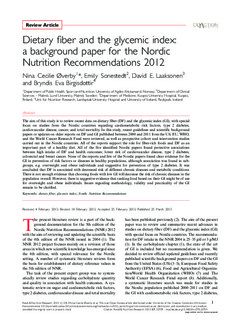| dc.contributor.author | Øverby, Nina Cecilie | |
| dc.contributor.author | Sonestedt, Emilie | |
| dc.contributor.author | Laaksonen, David E. | |
| dc.contributor.author | Birgisdottir, Bryndis Eva | |
| dc.date.accessioned | 2013-07-17T08:59:10Z | |
| dc.date.available | 2013-07-17T08:59:10Z | |
| dc.date.issued | 2013 | |
| dc.identifier.citation | Øverby, N.C., Sonestedt, E., Laaksonen, D.E., & Birgisdottir, B.E. (2013). Dietary fiber and the glycemic index: a background paper for the Nordic Nutrition Recommendations 2012. Food & Nutrition Research, 57. | no_NO |
| dc.identifier.issn | 1654-661X | |
| dc.identifier.uri | http://hdl.handle.net/11250/139057 | |
| dc.description.abstract | The aim of this study is to review recent data on dietary fiber (DF) and the glycemic index (GI), with special focus on studies from the Nordic countries regarding cardiometabolic risk factors, type 2 diabetes, cardiovascular disease, cancer, and total mortality. In this study, recent guidelines and scientific background papers or updates on older reports on DF and GI published between 2000 and 2011 from the US, EU, WHO, and the World Cancer Research Fund were reviewed, as well as prospective cohort and intervention studies carried out in the Nordic countries. All of the reports support the role for fiber-rich foods and DF as an important part of a healthy diet. All of the five identified Nordic papers found protective associations between high intake of DF and health outcomes; lower risk of cardiovascular disease, type 2 diabetes, colorectal and breast cancer. None of the reports and few of the Nordic papers found clear evidence for the GI in prevention of risk factors or diseases in healthy populations, although association was found in sub-groups, e.g. overweight and obese individuals and suggestive for prevention of type 2 diabetes. It was concluded that DF is associated with decreased risk of different chronic diseases and metabolic conditions. There is not enough evidence that choosing foods with low GI will decrease the risk of chronic diseases in the population overall. However, there is suggestive evidence that ranking food based on their GI might be of use for overweight and obese individuals. Issues regarding methodology, validity and practicality of the GI remain to be clarified. | no_NO |
| dc.language.iso | eng | no_NO |
| dc.publisher | Swedish Nutrition Foundation | no_NO |
| dc.rights | Navngivelse-Ikkekommersiell 4.0 Internasjonal | |
| dc.rights.uri | http://creativecommons.org/licenses/by-nc/4.0/deed.no | |
| dc.title | Dietary fiber and the glycemic index : a background paper for the Nordic Nutrition Recommendations 2012 | no_NO |
| dc.type | Journal article | no_NO |
| dc.type | Peer reviewed | no_NO |
| dc.rights.holder | © 2012 The Author(s) | |
| dc.subject.nsi | VDP::Medical disciplines: 700::Health sciences: 800::Nutrition: 811 | no_NO |
| dc.source.pagenumber | 16 | no_NO |
| dc.source.volume | 57 | no_NO |
| dc.source.journal | Food & Nutrition Research | no_NO |
| dc.identifier.doi | http://dx.doi.org/10.3402/fnr.v57i0.20709 | |

